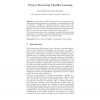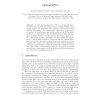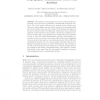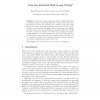95
Voted
FC
2009
Springer
15 years 4 months ago
2009
Springer
We present an efficient protocol for the privacy-preserving, distributed learning of decision-tree classifiers. Our protocol allows a user to construct a classifier on a database h...
98
Voted
FC
2009
Springer
15 years 4 months ago
2009
Springer
Abstract. This paper introduces certified sets to the private set intersection problem. A private set intersection protocol allows Alice and Bob to jointly compute the set intersec...
86
Voted
FC
2009
Springer
15 years 7 months ago
2009
Springer
In this note, we report on the first large-scale and practical application of secure multiparty computation, which took place in January 2008. We also report on the novel cryptogr...
87
Voted
FC
2009
Springer
15 years 7 months ago
2009
Springer
Abstract. The Chip Authentication Programme (CAP) has been introduced by banks in Europe to deal with the soaring losses due to online banking fraud. A handheld reader is used toge...
91
Voted
FC
2009
Springer
15 years 7 months ago
2009
Springer
Abstract. A certificate of authenticity (COA) is an inexpensive physical object with a random and unique structure S which is hard to nearexactly replicate. An inexpensive device ...
FC
2009
Springer
15 years 7 months ago
2009
Springer
This paper presents a hierarchy of privacy notions that covers multiple anonymity and unlinkability variants. The underlying definitions, which are based on the idea of indistingu...
107
click to vote
FC
2009
Springer
15 years 7 months ago
2009
Springer
We present a cryptographic protocol for conducting efficient, provably correct and secrecy-preserving combinatorial clock-proxy auctions. The “clock phase” functions as a trust...
85
Voted
FC
2009
Springer
15 years 7 months ago
2009
Springer
106
Voted
FC
2009
Springer
15 years 7 months ago
2009
Springer
Online advertisers face substantial difficulty in selecting and supervising small advertising partners: Fraud can be well-hidden, and limited reputation systems reduce accountabili...
FC
2009
Springer
15 years 7 months ago
2009
Springer
End-to-end voting schemes have shown considerable promise for allowing voters to verify that tallies are accurate. At the same time, the threat of coercion has generally been consi...




